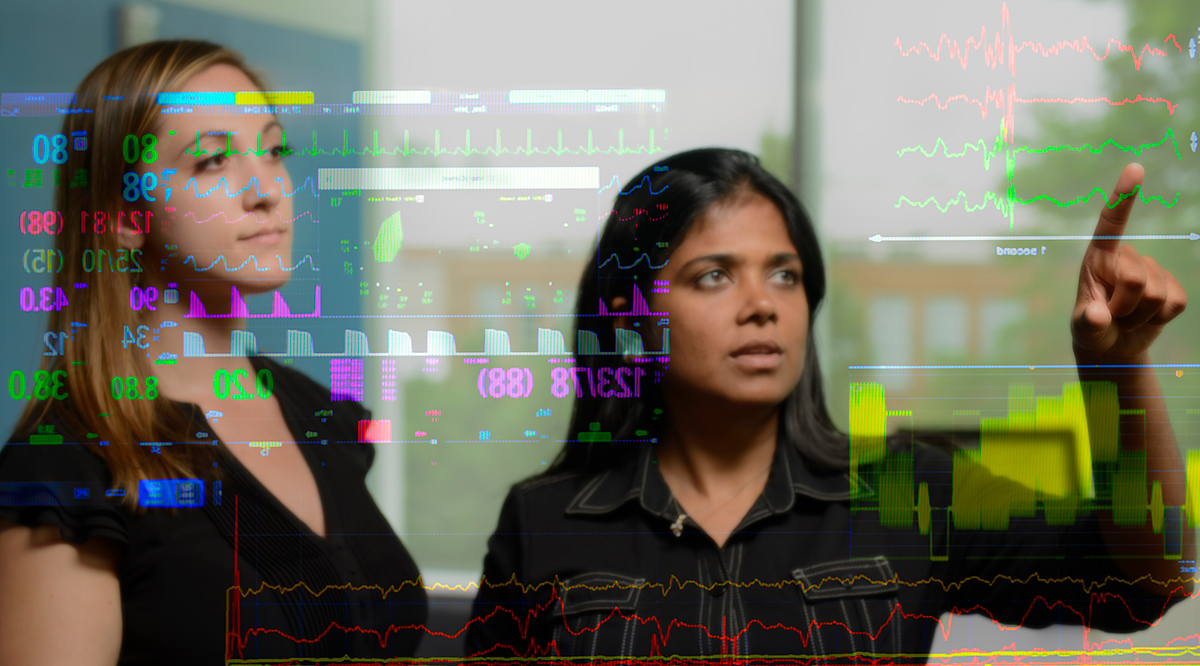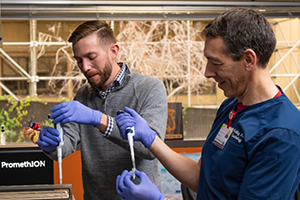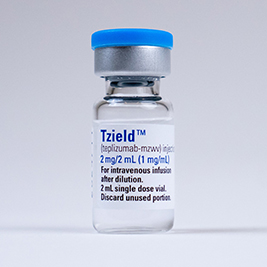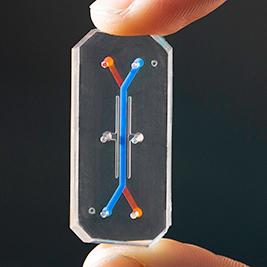
Gene sequencing at record speeds to identify dangerous mutations. A treatment that delays Type 1 diabetes for years. A vaccine to prevent RSV infections, which kill thousands of Americans each year.
Below we describe these and other recent developments in academic medicine that could help save the lives of millions of patients.
An RSV vaccine
Respiratory syncytial virus (RSV) made headlines this winter for its role in the tripledemic that, together with COVID-19 and flu, slammed many U.S. hospitals. But now there’s some good news related to RSV: On May 3, the Food and Drug Administration (FDA) gave its first-ever approval to a vaccine that protects against the dangerous condition.
Each year, RSV is associated with 6,000 to 10,000 deaths of U.S. adults 65 and older, and as many as 160,000 hospitalizations for that vulnerable group. It also kills hundreds of children under the age of 5.
“This is immensely satisfying,” says Ann Falsey, MD, a University of Rochester School of Medicine professor of medicine who has been pursuing an RSV vaccine for decades. “In science, even if you don’t make it across the finish line, you may feel like you contributed. But to actually see these products close to coming to market is huge.”
There are actually two RSV vaccines in the pipeline. The vaccine that was just approved by the FDA was developed by GlaxoSmithKline (GSK) and is targeted to adults 60 and older. Next, the Centers for Disease Control and Prevention will weigh in on whether to recommend the vaccine, and that’s expected to happen in June. The FDA is also expected to rule shortly on a Pfizer vaccine for that population. In addition, Pfizer has been granted priority review of a vaccine for use in pregnant people that’s intended to protect their infants after birth.
These vaccine advances all are thanks to a better understanding of how RSV works, especially a component called the fusion protein — F-protein for short. “If you inject the F-protein, then the body produces antibodies against it that bind to the virus, blocking it from entering cells,” says Falsey, who has researched the Pfizer RSV vaccine.
“I’ve seen the faces of patients [with RSV]. I’ve seen the suffering. It’s not abstract to me. So when I saw the results of the first study, I was dancing around my office.”
Ann Falsey, MD
University of Rochester School of Medicine
In trials, the GSK vaccine was 83% effective against confirmed RSV lower respiratory disease in people 60 and older, according to a study in the New England Journal of Medicine.
There was a possibly concerning side effect, though. A small percentage (1 out of some 12,000 in the GSK trial and 2 out of some 17,000 Pfizer recipients) developed Guillain-Barré syndrome, in which the immune system attacks a person’s nervous system. One Pfizer case was considered life-threatening, but researchers noted other possible causes for the condition in the three patients, and all survived.
“When the vaccines start to be given to millions of people, we will have to track them to see whether there is a slight increase in such rare side effects,” says Falsey. “If so, then it really becomes a discussion between a person and their physician as to the risk-benefit for that individual.”
Meanwhile, Falsey is well aware of the risks that derive from lacking a vaccine.
“I’ve seen the faces of patients [with RSV]. I’ve seen the suffering. It’s not abstract to me,” she says. “So when I saw the results of the first study, I was dancing around my office.”
Record-breaking gene sequencing

Gene sequencing to map a patient’s DNA can be crucial to identifying causes of life-threatening conditions. And doing so rapidly can reduce the need for other tests, cut the time patients spend in the hospital, and expedite vital precision treatments.
“Rapid” gene sequencing has generally meant a few weeks. At Stanford Medicine, a team recently shrunk that time to just hours.
The expedited approach, described in the New England Journal of Medicine in 2022, won the team a Guinness World Record.
More important, it achieved significant patient benefits, says team leader Euan Ashley, MB ChB, DPhil, associate dean and Roger W. and Joelle G. Burnell Chair in Genomics and Precision Health at Stanford School of Medicine.
One patient in the sequencing study, a 13-year-old boy, was suffering from a dangerous cardiac condition, and his organs were beginning to shut down. The team needed to know whether the cause was a passing heart infection or an irreparable DNA mutation. After sequencing revealed a genetic cause in just a few hours, the boy was added to the transplant wait list, and three weeks later, he received a new heart. “The standard test results didn’t come back until several weeks after he had the transplant,” says Ashley.
How did the team pull off the fast approach?
They took several steps, including harnessing the power of a sequencing machine many times faster than what’s typically used. They also processed the data in real time, as soon as they got it. To avoid overloading the lab’s computer system, they also shifted to computing in the cloud. There, algorithms rapidly scanned the patient’s genetic code for aberrations, and the research team then looked for variants of concern.
The gene sequencing study in which the boy participated included just a dozen patients, but Stanford is now working to roll it out to all those who might benefit, says Ashley. He’s also heard from some 20 hospitals worldwide that hope to replicate the approach.
Ashley says he’s thrilled by the patients the team has helped already.
“For every family we meet, this may be the most significant event that happens to them in their lives,” he notes. “To be able to produce results in one nursing shift that would have taken weeks or even months is really, really exciting.”
Delaying diabetes by years

Since the discovery of insulin in 1922, no drug has been able to alter the course of Type 1 diabetes — until recently.
Now the medication teplizumab delays onset of the condition by an average of two years — and sometimes by more than a decade, says Kevan Herold, MD, a principal investigator of the drug and an immunologist at Yale Medicine in New Haven, Connecticut.
That’s a significant development given that 30,000 U.S. patients are diagnosed with the autoimmune condition each year.
In those individuals, the pancreas produces little or no insulin, the hormone responsible for controlling blood sugar levels. Potential long-term consequences include damage to the heart, kidneys, arteries, and eyes. And if blood sugar levels suddenly drop too low, patients can even fall into a coma.
“People with Type 1 diabetes are dependent on insulin every moment of every day,” says Herold. “Even a week without the disease is a gift.”
Unlike Type 2 diabetes, which can be forestalled with lifestyle changes, Type 1 diabetes previously had not responded to efforts to prevent or delay it.
Herold and other researchers focused on people with a high likelihood of developing the disease, hoping to help them before their immune system destroyed much of the pancreas. They worked with an international network of clinical trial sites, TrialNet, to search for individuals with at least two Type 1 biomarkers and abnormal blood sugar levels. Such individuals are believed to have a lifetime risk of developing the disease that’s close to 100%.
The study, published in the New England Journal of Medicine in 2019, found that 43% of participants given the medication developed diabetes during the trial, compared with 72% of those in the placebo group.
Herold explains that teplizumab works by binding to immune cells called T lymphocytes, partially blocking their ability to destroy insulin-producing cells. The FDA approved teplizumab, which is sold as Tzield, in November 2022.
Herold hopes that this new strategy of preventive immune therapy can be applied to other autoimmune conditions where blood markers indicate likely disease development, such as rheumatoid arthritis and multiple sclerosis.
“Why should we have to wait to treat these conditions?” he says. “Coming in earlier when the pathology is not yet overt and damage is not already done seems a much better way to go.”
Speedier sepsis detection
Blood clots, leaking blood vessels, and organ damage all are possible outcomes of sepsis, the body’s extreme reaction to an infection. Each year in the United States, 1.7 million U.S. adults develop sepsis, and at least 350,000 either die in the hospital or are sent to hospice because of it.
Sepsis survival depends on rapid detection. That’s problematic because there is no one test for sepsis, and its symptoms mimic those of many other conditions.
Now, an artificial intelligence driven program developed at Johns Hopkins Medicine detects sepsis nearly six hours sooner on average than traditional methods.
“Hundreds of lives likely have been saved by the system,” says Albert Wu, MD, director of the Johns Hopkins Center for Health Services and Outcomes Research.
To create the process, called TREWS — Targeted Real-time Early Warning System — experts fed the AI algorithm thousands of previous patients’ health records so it could recognize signs of sepsis, explains Suchi Saria, PhD, director of the Machine Learning, AI and Healthcare Lab at Johns Hopkins.
“Hundreds of lives likely have been saved by the [sepsis detection] system.”
Albert Wu, MD
Johns Hopkins Center for Health Services and Outcomes Research
Once deployed, the AI tool rapidly processes reams of information about current patients.
“Multiple sources of data are automatically pulled, including lab tests and vital signs. [The AI] even reads provider notes looking for certain phrases, and it does this continuously,” says Wu, who contributed to the tool’s design and evaluation.
When the tool identifies an at-risk patient, it fires off an alert to the physician. It includes an explanation of why it’s flagging the patient as well as evidenced-based recommendations for how to proceed.
Hopkins tested the system in five hospitals with 4,000 clinicians and 590,000 patients over two years. Sepsis-related deaths dropped by 20%, according to a July 2022 study published in Nature.
“This is the first case where artificial intelligence was used on a large scale by frontline clinicians in hospitals,” says Wu. He notes that the platform, which is being disseminated by AI company Bayesian Health, is being used to try to detect other conditions.
“Using this platform, you can predict if someone is going to develop kidney failure or heart failure. You can predict that a patient is deteriorating or that they wouldn’t be able to live independently when they left the hospital,” he says. “If you have good data, you should be able to predict so many things that can help improve patient care.”
Vagina on a chip

Scientific understanding of the vagina is crucial to the health of millions of women, yet it has remained severely limited. That’s partly because of some patients’ hesitation to participate in vagina-related clinical trials but also because research has for so long focused more on men, experts say.
“Unfortunately, women’s health has been ignored too much,” says Donald Ingber, MD, PhD, a cell biologist at Harvard Medical School in Boston.
Now, Ingber has created a device that functions much like an artificial vagina. The inch-long, clear silicone chip contains human cells and effectively replicates conditions in the real-life organ.
Animals don’t work well as a research stand-in because their cycles differ so dramatically from those of humans, says Ingber, who directs Harvard’s Wyss Institute for Biologically Inspired Engineering. Vaginal cells placed in a petri dish also perform poorly.
So Ingber, who previously created other simulated organs, including lungs and livers, set out to formulate a vagina on a chip. He used two types of cells: one from the lining of the vagina and another from the connective tissue that runs under it. These lie on either side of a permeable membrane to replicate the 3D structure of the vaginal wall. The team also added fluids above and below the tissues to mimic such substances as vaginal secretions and blood supply.
Next the researchers tested the apparatus to see if it responded realistically to various inputs. Introducing “good” bacteria yielded positive effects like reduced inflammation. Introducing bugs associated with bacterial vaginosis — a condition that brings several risks, including premature birth if contracted during pregnancy — wreaked the same havoc as in the human body.
Ingber says that the chips, which are being mass produced by Emulate Inc. (a Boston-based company he founded), will enable researchers to test numerous substances and theories, including whether probiotics boost vaginal health. He’s also making chips using cells from members of different ethnic groups to learn whether they produce divergent results. And his team is introducing sperm to the chip to assess how vaginal changes impact fertility.
“Basically,” says Ingber of the device, “you can explore nearly any question that you could in a human.”
